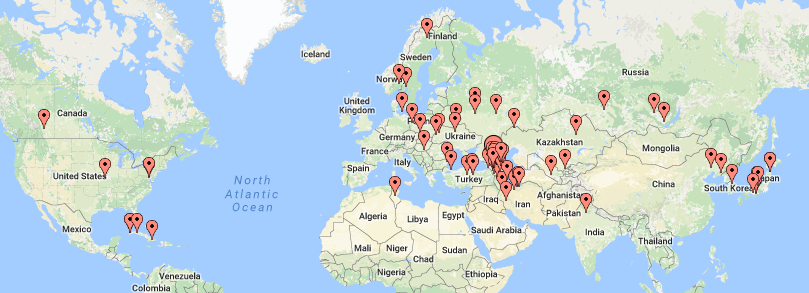Rio Wrestling Medalists: Maps From Whence They Came
Rio Wrestling Medalists: Maps From Whence They Came
We analyze a map of where all the 2016 Rio Olympic wrestling medalists came from.

Unlock this article, live events, and more with a subscription!
Already a subscriber? Log In
Another Olympics is in the books and a few weeks have passed since the closing ceremony, allowing us ample time to digest and analyze the results.
As is par for the course, Russia, and the other former Soviet Republics, dominated the medal table. But it was not all business as usual in Rio de Janeiro. Fewer total medals were distributed to competitors in Men's Freestyle and Greco-Roman than in previous Olympic Games, and more medals were bestowed to Women freestylers. This was due to the redistribution of weight classes to an even six across all three styles.
To see how the pendulum of wrestler power may have swung (or stayed in place) as a result, I've recorded the birthplace of every wrestling medalist from the Rio Games and plotted those locations on a map.
As you can see from the pinpoints below, the Southern Hemisphere has a lot of catching up to do in the sport of wrestling.

The Western Hemisphere did not exactly cover itself in glory, either, with PanAmericans accounting for a mere 7 of the 72 total medals distributed at the 2016 Summer Games, all from either Cuba, the USA or Canada. Africa produced a solitary medalist, Tunisia's Marwa Amri (WFS 58kg bronze), while Southeast Asia, Australia and Oceania came home with zilch.
Meanwhile, Sweden's Sofia Mattsson (WFS 53kg bronze) wins the Santa Claus award for being the medalists born closest to the North Pole.
The regions around the Black and Caspian Seas, on the other hand, were exceedingly productive. The Caucasus Mountains and their surroundings were especially fertile, producing 28 Rio medalists, as seen in the map below.

When only male Freestylers are considered, the concentration is even more pronounced. 20 of the 24 Rio medals were earned by competitors born between Turkey and Uzbekistan. Only Cuba's Frank Chamizo (65kg bronze, born in Cuba), Japan's Rei Higuichi (57kg silver, born in Osaka) and the two American medalists, Kyle Snyder (97kg gold) and J'Den Cox (86kg bronze) were not reared in the lands flanking the Seas called Black and Caspian.
Filtering our pinpoints to Men's Freestyle only, the map below is able to captures the birthplace of over 83% of the 2016 medalists.

For all of Russia's geographic expanse, their Freestyle talent is very much concentrated in the Caucasus Mountain region. The lone team member not from that area, Viktor Lebedev (born in Yakutsk, Siberia, far to the northwest of the Caucasus), failed to make the podium.
To further illustrate the astounding concentration of wrestling talent, we can zoom in on our Men's Freestyle map closer yet. The map below captures eleven medalists, including three of the six gold medal winners.

For the sake of comparison, below is a similar snapshot of the United States, covering the same square mileage and centered on the current freestyle hotbed of North America (based on medal count).

We can also produce separate maps for each style to see how the geography differs between gender and leg grabability. Below is a map of only the 24 Men's Freestyle medalists, the pinpoints of which are, if you haven't been paying attention, centered around the Caucasian Isthmus:

Though the map of the birthplaces of Greco-Roman Rio medalists maintains the same mountainous epicenter as Men's Freestyle, there is, however, a greater geographic diffusion of talent. As seen below, the medalists are spread out a little further amidst Asia and Europe, although production in the Western Hemisphere remains paltry. Additionally, Africa and the whole of the Southern Hemisphere were, like their Men's Freestyle counterparts, shut out of the awards ceremonies.

Women's Freestyle shows the greatest variety in geographic birthplaces. Notably, the world's two most populous countries, India and China, finally get in on the action. And in a reversal of fortune, the Caucasus region, and essentially all of the Middle East, are void of naturally born medalists, as seen in the map below.

Another way to analyze the relative strength of the various wrestling producing parts of the global is with a heat map by birth country of the medalists. For the heat maps, I introduced a simple point scale for the different medals, 5 points for gold, 3 for silver, and 1 for bronze.
Below is the heat map for Men's Freestyle.

Next, the same map and scale but with only Greco-Roman medalists.

Finally, a map for just Women's Freestyle.

One other thing our birthplace data can help illuminate is the dynamics of when wrestlers, for whatever reason, were born in one country but wrestler for another's team.
Without getting into the particulars of why and steering clear of any debate as to whether or not this is a good thing for the sport, we can create two contrasting graphs, one of points-scored by a wrestler's birth country, and another of points scored by each national team, using the same point scale as the heat maps.


Azerbaijan stocked their team with transplants from Russia, Ukraine and Iran, which boosted their results relative to the country's locally born competitors. Turkey has likewise benefited from wrestlers born outside their borders. Russia, a font of medalists for Belarus, Kazakhstan, Uzbekistan and Romania, also earned points for two golds from wrestlers born in Georgia (or at least Georgia's internationally recognized legal borders).
While it was no surprise to find out that many world class wrestlers hail from the Caucasus Mountains, perhaps the bigger question is if the factors that allow this region to be so successful can be identified, and even more importantly, replicated? That is the challenge for the American and so many other national federation coaches to ponder.